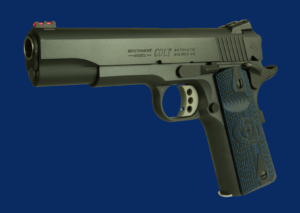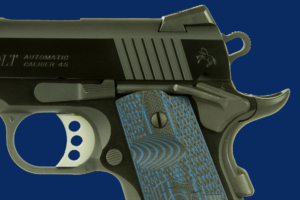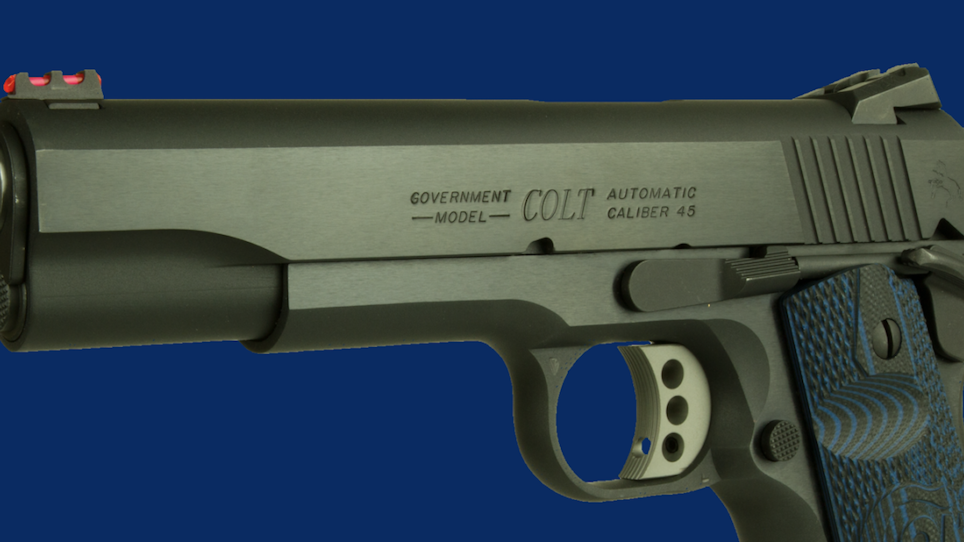Colt has been making 1911s since the gun was first adopted by the U.S. military and has built them for combat as well as competition, improving them along the way.
The Colt Competition Pistol line was developed specifically so competitors could buy an off-the-shelf gun and take it to a match without having to make any modifications. A nice feature of the 1911 Competition Pistol is it can easily serve as a self defense handgun for everyday carry, making it a versatile choice for shooters interested in self protection as well as competition.
Many years ago, in an effort to make the 1911 as safe to carry as possible, Colt designed the Series 80 firing system and used it in the Colt Competition line. The Series 80 system introduced a passive safety to block the forward motion of the firing pin so it could not strike the primer unless the trigger was pulled. This change was meant to prevent a potential unintentional discharge if the gun was dropped and inertia drove the firing pin forward to strike the primer.
Many other modern firearms feature a similar system. To work, pulling the trigger to the rear must move a mechanical linkage, a lever in this case, so it presses on a plunger to disengage the passive firing pin block. This allows the firing pin to move all the way forward and hit the primer. Some shooters have complained that this Series 80 system ruins the fine trigger pull of the 1911.

Shooters who want the original 1911 firing system can get it in the Competition 1911 chambered in .45 ACP, .38 Super or 9mm. The guns are available in stainless steel or a blued finish. (Photo: Doug Larson)
Time for a change
The original firing system without the passive firing pin block, and called by Colt the Series 70 system, was not available in the Colt Competition Pistol line until recently. That has changed, and now shooters who want the original 1911 firing system can get it in the Competition 1911 chambered in .45 ACP, .38 Super or 9mm. The guns are available in stainless steel or a blued finish.
Colt sent a blued 1911 Government Model Competition, without the firing pin safety, chambered in .45 ACP for testing and evaluation. The sample gun has a nicely executed shiny blue finish on the sides of the steel frame and slide, while the rounded surfaces on the top of the slide, bottom of the frame and front strap are matte blue.
Up top, the slide features a red fiber-optic front sight dovetailed into the slide. Originally, the Competition models featured a blue fiber optic, but that color proved to be less than satisfactory for many shooters because it did not draw the eye and seemed to fade out in anything but very bright sunlight. However, Colt does supply a blue fiber- optic tube and other color tubes that the owner can easily install. At the rear of the slide, Colt installs a Novak LoMount Adjustable rear sight. It’s plain black, with no dots, which will delight some but be disliked by others. Regardless, the Novak LoMount rear sight has become a standard and is often imitated.
While the rear sight has the familiar Novak sight profile, it can be adjusted for elevation by turning a screw, and adjusted for windage after loosening a screw and drifting the sight to the right or left. The adjustable feature is particularly nice since, with any gun, different loads will typically shoot to a different point of impact. The adjustable feature allows a competitor to adjust his gun to his selected load. A shooter who carries the gun for self defense can also benefit from the ability to adjust the sight. And unlike so many adjustable rear sights, this one has no sharp edges to cut the hand when racking the slide. It's robust, too, with Novak reporting an extremely low return rate.
Deep, wide serrations are located at the rear on both sides of the slide and provide a solid grip when racking. The familiar rampant Colt logo is located on the rear left side of the slide and the words COLT GOVERNMENT MODEL AUTOMATIC CALIBER .45 are on the same side above the trigger guard. On the right side below the ejection port are the words COMPETITION SERIES. And, as is expected on a competition 1911, the ejection port is wide and flared.
The long, skeletonized aluminum trigger is serrated and has an overtravel adjustment screw, but there was no discernible overtravel on the test gun, so it was properly set at the factory. The thumb safety is wide and easy to manipulate, but is not ambidextrous since it is located only on the left side. The slide catch, also located on the left side, provides plenty of purchase when being engaged and works positively, locking the slide back after the last round in the magazine is fired. And the magazine release is nicely checkered and works correctly, allowing the eight-round stainless steel magazines supplied with the gun to drop freely when activated.
The frontstrap is smooth, which some people will criticize and others will praise. The heavy checkering that is common on custom 1911s is often so abrasive that during extended shooting sessions or heavy training, it will actually abrade the skin to the point that blood is drawn. At the top of the frontstrap, the trigger guard is undercut, allowing a slightly higher grip, which is designed to help the shooter control recoil.
The straight mainspring housing has vertical serrations to provide a more slip- resistant surface, and combined with the rough surface of the blue G10 grips, anchors the gun in the hand. The G10 grips are attractive, with a blue and black color scheme and stylized word Colt embossed on each panel. G10 grips are made by VZ Grips using fiberglass composites that are impregnated with a synthetic resin and then treated with heat and pressure-transforming the composite into a solid laminated plastic that is lightweight, resistant to moisture and very durable. The G10 composite feels sharp to the touch to resist slippage but is not so sharp that it is abrasive to skin. The left side G10 grip panel has a relief cut to allow the thumb easier access to the magazine release.
At the bottom of the grip, the magazine well is nicely beveled to assist in the rapid insertion of a magazine. The Competition 1911 is also equipped with an extended beavertail grip safety, complete with a palm bump to help assure proper activation.
A stainless steel National Match barrel is nicely fitted to the frame, bushing and slide, and as previously mentioned, the ejection port is wide, lowered and flared to assure positive ejection. Borrowed from a new recoil spring system developed for one of the services to improve service life and reduce felt recoil, the Competition gun has dual recoil springs consisting of an outer and inner spring that ride on a conventional, but smaller-diameter, recoil spring guide. Comparing two guns of the same model and same caliber, but with conventional and dual recoil springs, the felt recoil generated by the gun with the dual springs is noticeably less.

Colt installs a long, skeletonized, lightweight aluminum trigger in the Competition Series 1911. It is adjustable for overtravel and breaks cleanly with no creep thanks to the Series 70 firing system. (Photo: Doug Larson)
Series 70 System
The big news, of course, that makes this gun different from previous Government Model Competition 1911s is the fire control system mentioned earlier. The Series 70 system, which this gun sports, is the one originally designed by Browning for the 1911 and does not have the passive firing pin block of the later Series 80 system.
Comparing two recently produced, off-the-shelf Government models featuring the Series 80 system with an original Series 70 Government Model and the test gun with its Series 70 system revealed a noticeable difference in trigger pull. Both Series 80 guns exhibited a bit of creep prior to a crisp break. The creep seemed to be attributable to the linkage pushing the passive firing pin block plunger.
On the other hand, the Series 70 guns — including the new test gun supplied — had no creep prior to a crisp break. This feature is important to some buyers and not others, but there is definitely a difference in the trigger stroke. So for customers demanding the original fire control system that Browning designed, which does not introduce the creep associated with the passive firing pin block, Colt has listened and is delivering.
During testing the sample gun with a variety of ammunition, no malfunctions were experienced. The two supplied eight-round stainless steel magazines functioned well and fell free of the gun when the magazine release was pressed.
Accuracy exhibited by the test gun is better than that generally thought of as necessary in a self-defense or action shooting competition gun, with groups at 25 yards off a bench rest averaging a little more than 2 inches to just under 4 inches. However, for accurate bull’s-eye shooting, some shooters may find the bright fiber optic distracting, making it more difficult to obtain a good sight picture. As mentioned earlier, though, Colt thoughtfully supplies replacement fiber-optic tubes of different colors.
Colt is listening to its customers and making efforts to bring them the guns they want at prices that are competitive. And as Colt's public relations and advertising efforts continue, retailers are likely to get more inquiries regarding Colt's products. For more information, contact Colt’s Manufacturing Company, 800-962-2658, www.colt.com.
SPECIFICATIONS
COLT COMPETITION GOVERNMENT MODEL – SERIES 70
Caliber: .45 ACP
Barrel length: 5 inches
Overall length: 8.5 inches
Weight: 36 ounces unloaded
Grips: G10 synthetic
Sights: Genuine Novak adjustable rear and fiber-optic front
Action: Single action
Finish: Blued
Capacity: 8 + 1 rounds
Price: $899
PERFORMANCE
COLT COMPETITION 1911
Accuracy
Load Velocity (fps) Average Best
Federal 230 Hydra-Shok JHP 888 1.99 1.45
Hornady 185 Critical Defense FTX 1,001 2.82 2.33
Winchester 230 Bonded PDX1 913 3.54 3.42
Bullet weight measured in grains, velocity in feet per second 15’ from the muzzle by chronograph and accuracy in inches for three five-shot groups at 25 yards.






